Custom Design
Imagine this: your colleague makes a social media post with the incorrect blue color, your freelancer produces a brochure with a logo in the old version, and your website uses fonts that differ from your printed material. Ring a bell? Without an all-encompassing brand style guide, your best-intentioned colleagues can unwittingly harm your brand’s reputation and lose your audience.
A brand style guide is your visual playbook, guaranteeing every touchpoint communicates your brand consistently and at a professional level. When customers receive jarring visual messages, they lose trust more quickly than you may think – research indicates that consistent brand presentation can boost revenue by as much as 33%.
This page will guide you on how to design a strong brand style guide that dispels visual ambiguity, instills unshakeable brand trust, and equips your team to represent your brand accurately each and every time.

A brand style guide is an in-depth document that dictates exactly how your brand is supposed to look, sound, and feel everywhere and on everything. Consider it your brand’s constitution – a system of rules and guidelines that dictate every visual and messaging choice your company makes.
The guide is used as visual identity architecture, encompassing everything from your logo requirements and brand color palette design through to typography guidelines and photography approaches. Instead of having creative choices dependent on chance or individual taste, it offers crisp, actionable guidance that anyone collaborating with your brand can use.
Brand identity guidelines aren’t pretty books that gather dust on a shelf. They’re functional tools that safeguard your brand investment and guarantee each encounter supports your desired brand impression. When put into practice, they turn disparate visual elements into a unified professional brand system that fosters recognition and trust.
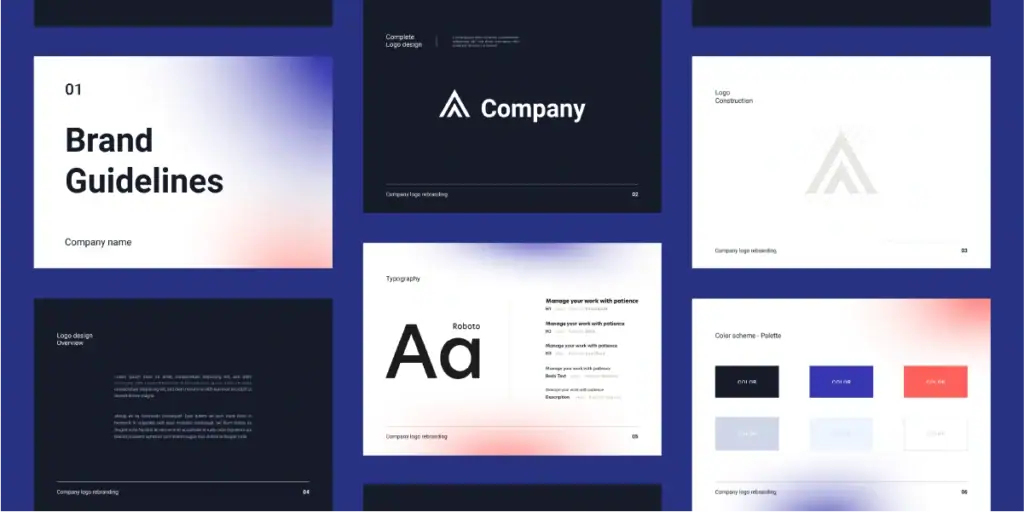
Developing and sustaining visual brand consistency is not simply about appearing professional – it’s about safeguarding and extending your business investment. The following are a few reasons all businesses require thorough brand identity guidelines:
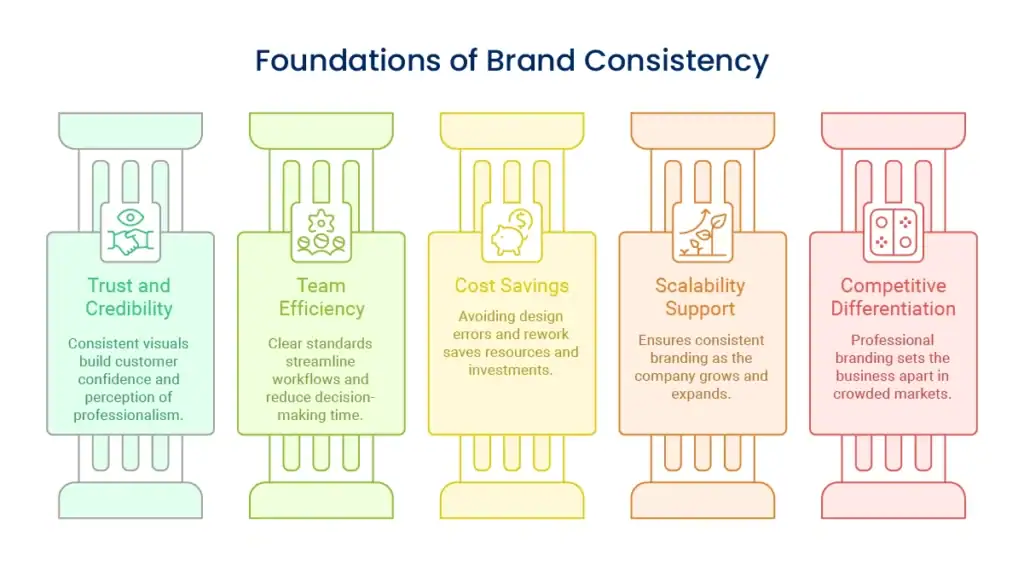
Consistent visual presentation conveys professionalism and attention to detail. When customers experience the same colour schemes, font choices, and design elements on your website, social media, and printed documentation, they find your business established and credible.
Clear logo use guidelines and typography standards take the guesswork out of what to do for your team. Rather than arguing what blue to use or where to place your logo, everyone uses the same standards. This cuts down on revision cycles and accelerates content production.
Conservation Without a style guide, companies tend to redo design components from scratch or repair inconsistent materials retrospectively. A style guide keeps expensive errors at bay and saves your brand strategy investment.
As your company expands and you have more staff members, freelancers, or agencies, your style guide guarantees that everyone can represent your brand appropriately without being continuously overseen or explained.
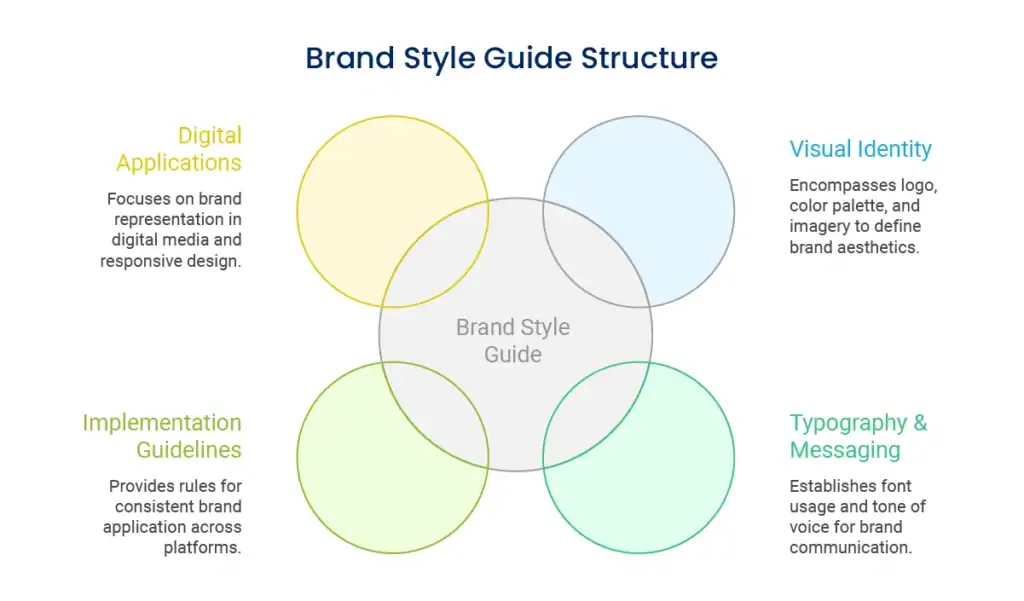
Your visual identity architecture is the foundation of your entire brand system. Your foundation consists of your main logo, alternative logo variations, and clear guidelines for when and under what circumstances to utilize each variation.
Begin with your primary logo and record its minimum size specifications, safe area requirements, and approved background colors. Develop versions for various applications – horizontal arrangements for headers, vertical forms for social media profiles, and streamlined forms for small apps like favicons.
Your color palette design for your brand must contain primary colours, secondary supporting colours, and neutral tones. Provide precise colour codes for print (CMYK), digital usage (RGB), and web usage (HEX codes). This avoids the usual issue of colours appearing differently on different platforms and materials.
Type guidelines define the personality and readability of your written content. Pick primary fonts for headlines, secondary fonts for body text, and detail how they can be combined.
Take into account both digital and print uses when picking fonts. Web-safe fonts are guaranteed to display correctly on multiple devices and browsers, while print fonts may allow more creative latitude in marketing materials.
Your recurring brand messaging piece should define your brand voice, tone, and key messages. This would encompass writing style guidelines, preferred vocabulary, and messaging hierarchy to reinforce your overall brand positioning.
Implementation guidelines convert your brand elements into usable, day-to-day applications. Include in this section templates for frequent materials such as business cards, letterheads, presentations, and social media updates.
Make good and bad examples. Demonstrate what your logo must not do – stretched out, inappropriately recoloured, or set against busy backgrounds. These “don’ts” will be even more useful than the “dos” since they avoid mistakes.
Record your photography and imagery style preferences. This may involve colour treatment, composition best practice, subject matter preference, and image quality standards. Visual consistency is more than just logos and colours and applies to every image that reflects your brand.
Your brand must function perfectly across digital platforms, from website headers to mobile application icons. Digital brand applications demand specific attention to screen readability, loading speeds, and user experience.
Create specifications for social media apps, such as profile picture requirements, cover photo guidelines, and post design guidelines. There are unique requirements and best practices for each platform that your style guide must cover.
Think through how your brand elements look when they stretch or shrink on various screen sizes. Your logo must be legible both on big desktop monitors and on tiny phone screens. Font styles must be readable at a variety of sizes while delivering your brand personality.
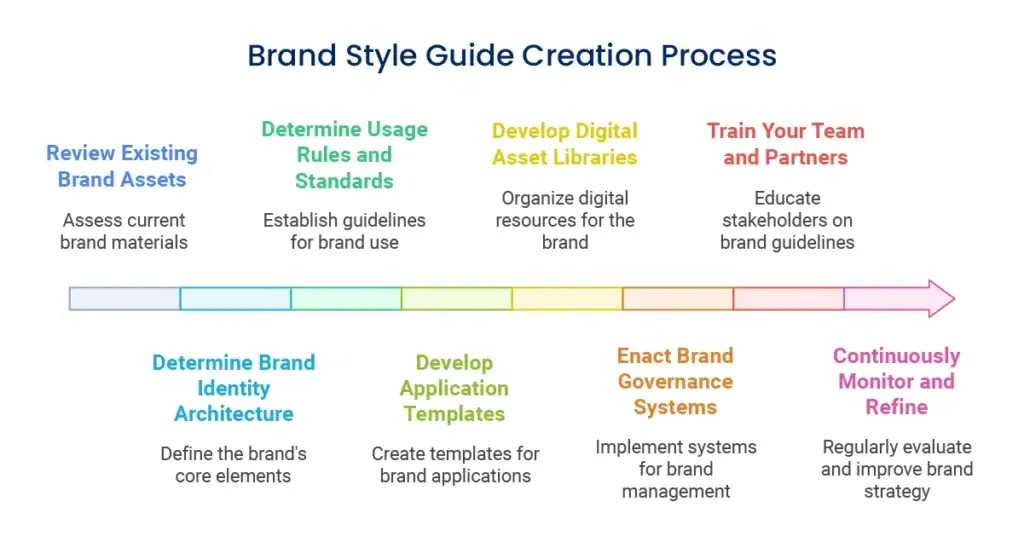
Start by gathering all branded items your business is already using. These can be logos, marketing pieces, website components, social media images, and any other visual elements.
Note where they’re prominently wrong and take note of what’s going right. You may find that social media is using a different blue from your site, or that individual team members have been using different logo iterations.
Make an in-depth inventory of what you’ve got vs. what you lack. This audit uncovers holes in your existing brand system and assists in prioritising elements that must be addressed first.
Begin with your essential visual components – logo, colours, and typography. These will guide each additional decision within your style guide.
If you are starting from scratch with new brand elements, determine if they accurately convey your existing business position and target market. Occasionally companies grow beyond their initial branding and must be updated to remain relevant and professional.
Go through each element methodically, taking note of specifications and developing multiple versions for various uses. For your brand identity design should be versatile enough to apply across multiple contexts yet remain consistent in recognition.
Establish definite, detailed guidelines for the use of each brand element. Abstract guidelines such as “use sparingly” or “use within brand feel” are too subjective and open to interpretation, leading to inconsistent use.
State minimum sizes, spacing requirements, approbated colour pairings, and uses to avoid. Illustrate with visual examples demonstrating correct and incorrect uses.
Document these rules in language that non-designers can understand and follow. Your guidelines will be used by team members with varying design experience, so clarity is essential.
Create templates for commonly used materials like presentations, social media posts, email signatures, and marketing collateral. These templates ensure consistency while making it easy for team members to create professional-looking materials.
Templates must be versatile to support diverse content without compromising brand consistency. Provide guidance on how to customize templates and under what circumstances custom design effort may be required.
Think in terms of both digital and print templates, since each medium presents unique requirements and capabilities.
Centralize all your brand materials in accessible digital libraries. These include logo files in different formats, colour schemes, font files, and template materials.
Utilize cloud storage systems that enable members to access up-to-date versions while avoiding unauthorized changes. Version control becomes essential as your brand grows and changes.
Name files clearly and add concise summaries of when to use each asset. This avoids confusion and helps team members choose correct materials for their projects.
Implement processes for ensuring brand consistency as your company expands. These involve approval processes for new materials, ongoing brand audits, and update procedures for your style guide.
Designate brand guardians within your organisation who can review materials before publication and provide guidance when questions arise. This doesn’t need to be a formal role, but someone should take responsibility for maintaining standards.
Create a feedback system for improving your style guide based on real-world usage. Team members will discover gaps or unclear instructions that need addressing.
Take training sessions to guide team members through your new style guide. A mere provision of the document is not enough – active training ensures everyone comprehends and implements it in the right way.
Engage external partners such as freelancers, agencies, and vendors in your training too. They must know your standards as well as an internal team member.
Offer continuous support and respond to questions as they come up. Brand guidelines are most effective when everyone feels confident applying them instead of being intimidated by strict rules.
Periodically check how your brand looks across touchpoints and detect where consistency may be falling through. Brand monitoring must be a continuous process instead of being a one-time installation.
Revisit your style guide as your business grows or as you find more effective ways of applying your brand. Your guidelines must be dynamic documents that develop with your business requirements.
Monitor the business metrics that result from enhanced brand consistency. This could be customer recognition, trust ratings, or even sales results since how you appear professionally affects the purchase decision.

Accurate technology implementation turns your brand style guide from a static report into a dynamic system that fuels your team’s everyday work. Cloud-based asset management software assures everyone gets access to latest brand materials while keeping old versions from circulating.
Look into using digital asset management platforms that have approval workflows, version control, and automated delivery. As your team expands or when collaborating with outside partners who require access to brand assets, these systems are especially worth it.
Integration with content marketing software and social media management tools can automatically enforce brand guidelines to your content production process. This minimizes human effort and maintains consistency in all your communications.
The template automation tools may be used by team members to design branded materials without needing design skills. Properly set up, these tools avoid typical errors while ensuring professional quality in all your materials.

Your brand must look and feel perfect on every customer touch point, from your website and social media to print pieces and locations. Cross-platform consistency demands the unique considerations for each platform with a single brand recognition throughout.
Digital environments tend to have varying technical needs and user expectations. Your style guide must provide answers to how brand elements transition across different screen sizes, loading scenarios, and interactive components without compromising on their key attributes.
Print materials have varying colour specifications and resolution needs compared to digital usage. Set out these technical distinctions in a clear manner so that team members know when and how to utilize various asset versions.
Physical uses such as signage, uniforms, or packaging face special challenges that require special guidelines. Think about how your brand is going to be converted into three-dimensional uses and various materials.
As your business continues to grow, your brand system must mature to accommodate more advanced applications and messaging strategies. Sophisticated brand system development involves establishing sub-brands, campaign-specific editions, and international variations while still providing core brand identification.
Create brand extension guidelines that preserve family similarity yet permit targeted audiences or product differentiation. This is especially necessary as companies diversify service lines or expand into new market segments.
Think about developing seasonal or campaign-based brand extensions that bring the freshness factor without sacrificing consistency. These extensions should come across as genuinely linked to your main brand yet offer adaptability for varying marketing efforts.
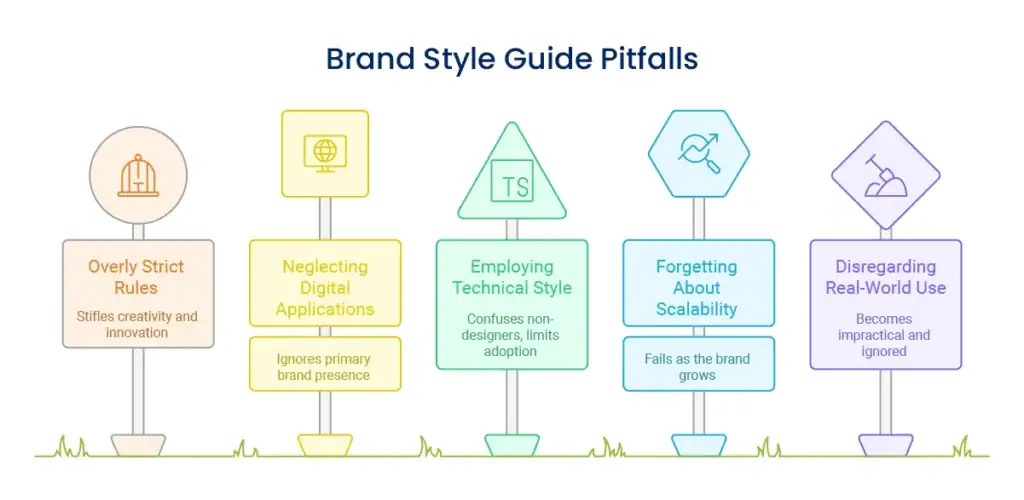
While consistency is ideal, overly strict rules will crush imagination and make your brand seem stale. Design flexibility into your system for interpreting ideas creatively without undermining core standards.
Most style guides concentrate on traditional print usage while providing inadequate attention to online requirements. Your brand is mostly online, so online guidelines must be practical and thorough.
Technical style guides full of design lingo become overwhelming and unusable for non-designers. Write guidelines in simple language that everyone can comprehend and work from confidently.
Rules that are effective for a small team may prove cumbersome as your business expands. Think about how your brand system will be applied by larger teams, external partners, and varying levels of skill.
Beautiful guidelines that are not developed according to practical limitations tend to get disregarded. Consider time limitations, technical abilities, and budget constraints when establishing your standards.

Current brand management is becoming more dependent on technological solutions that automate consistency while offering flexibility across various uses. Artificial intelligence and machine learning technologies have the ability to assist with maintaining brand standards across high volumes of content while alerting on possible inconsistencies.
Think about how next-generation technologies such as augmented reality, voice UIs, and interactive media will influence your brand presentation. Brand systems that are forward-looking consider these changing touchpoints while keeping the essence of recognition factors intact.
Brand tracking software helps to monitor how your brand looks on digital platforms and notify you of unauthorized use or inconsistencies. It’s especially useful for businesses with high online visibility or several content creators on your team.
Integration with marketing automation systems means that your brand guidelines are enforced consistently throughout email marketing, social media posting, and digital marketing without needing to manually monitor each item of content.

Uniform brand presentation creates recognition and trust that directly equate to business worth. Uniform brand presentation companies usually enjoy higher customer loyalty, improved referral rates, and premium pricing opportunities.
Your brand style guide safeguards this investment by making every interaction align with your desired brand perception. Through time, this consistency accrets brand equity that is an important business asset.
Track the business effects of enhanced brand consistency through measures such as customer recognition rates, trust levels, and improvement in conversions. The data serves to justify the ongoing investment in brand management and inform future brand choices.
Think about how your brand rules aid your overall brand strategy development and business goals. Successful brand management is business-driven as opposed to being an isolated creative endeavor.
Look over your brand style guide once a year or when there are significant business changes. These include significant product releases, target audience developments, or competitive arena changes that could influence your brand positioning.
Infrequent revisions for new uses or enhanced clarity can occur with some frequency, but comprehensive revisions should be well-planned to prevent derailing existing brand recognition.
Track how your brand is doing in the market and feedback from staff under the guidelines. This can indicate whether revisions are actually needed or if more training will simply fix usage problems.
Begin with your logo guidelines, main colours with precise codes, and elementary typographic guidelines. These essential elements avoid the most frequent consistency issues without being too much work for small teams.
Include app templates for your most commonly reused materials – usually social media updates, business cards, and slides. These templates give instant benefit while setting up consistent habits.
Increase your guidelines incrementally as your company grows and your branding requirements become more sophisticated. Beginning with simplicity and building in an orderly fashion usually proves more effective than developing exhaustive guidelines that bog down small teams.
Offer in-depth onboarding for new partners that encompasses both the style guide and training on how to effectively use it. Don’t count on the delivery of the document being enough to assure correct usage.
Make brand compliance requirements a part of contracts and project specifiers. Upfront clear expectations avoid expensive changes and guarantee professional outcomes.
Implement review and approval processes for materials created by partners prior to going live. The quality control step identifies issues early while offering learning opportunities for future projects.
International brand consistency demands striking a balance between global brand elements and local market modifications. Create models that determine what stays same across the globe and what can vary with local tastes and cultural needs.
Core brand values, visual identity components, and core positioning must stay the same in markets. Local modifications may involve language translation, cultural colour sensitivity, and market-specific communication strategies that keep overall brand consistency.
Partner with local digital marketing agencies familiar with both your brand guidelines and local market conditions. Give them clear instructions and approval cycles that ensure consistency without hindering effective local market interaction.
Developing a thorough brand style guide removes visual dissonance while establishing the professional image your company requires to succeed in saturated markets. When all team members, partners, and vendors adhere to the same standards, your brand has a refined, dependable image that consumers remember and trust.
The return on investment in creating detailed brand identity guidelines is reduced cost of revisions, quicker content generation, and increased customer recognition. Your style guide is a business asset that safeguards and reinforces your brand investment and facilitates sustainable growth.
Remember that effective brand guidelines balance consistency with flexibility, providing clear standards while allowing for creative interpretation that keeps your brand fresh and engaging.
Creating thorough brand guidelines demands strategic thought coupled with real-world implementation skill. Our brand identity design team assists companies in designing style guides that deliver in the real world and establish lasting brand equity. We recognize the symbiosis between creative consistency and real-world usability that makes brand guidelines really effective for expanding businesses.

Enter your email to get instant access